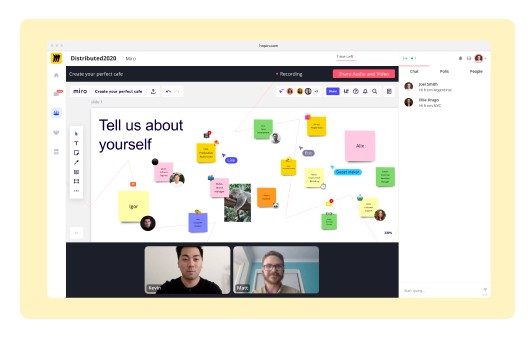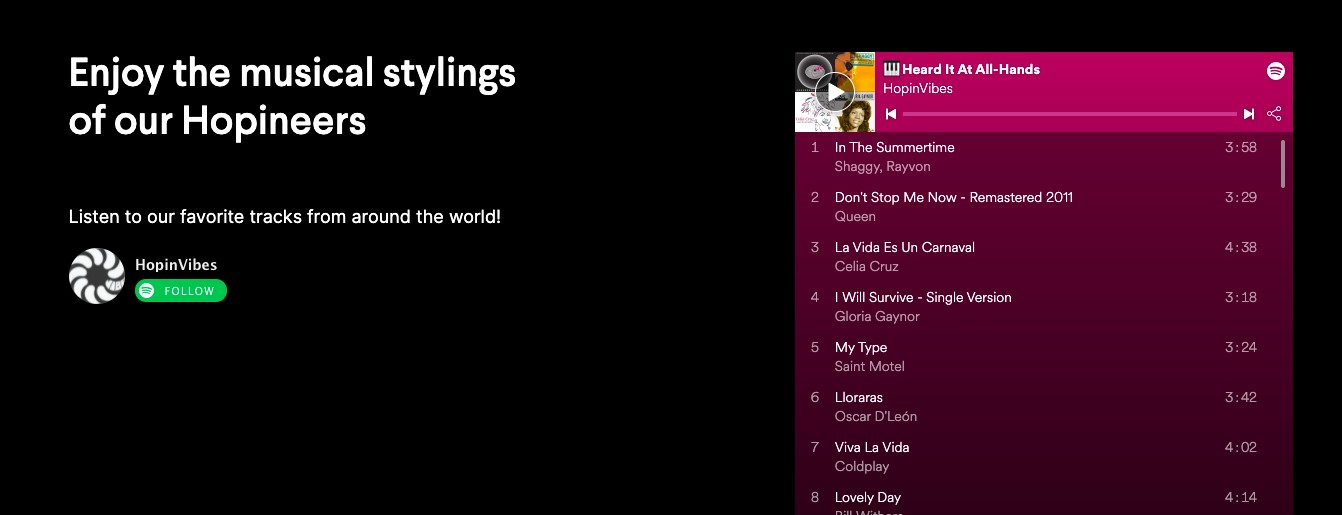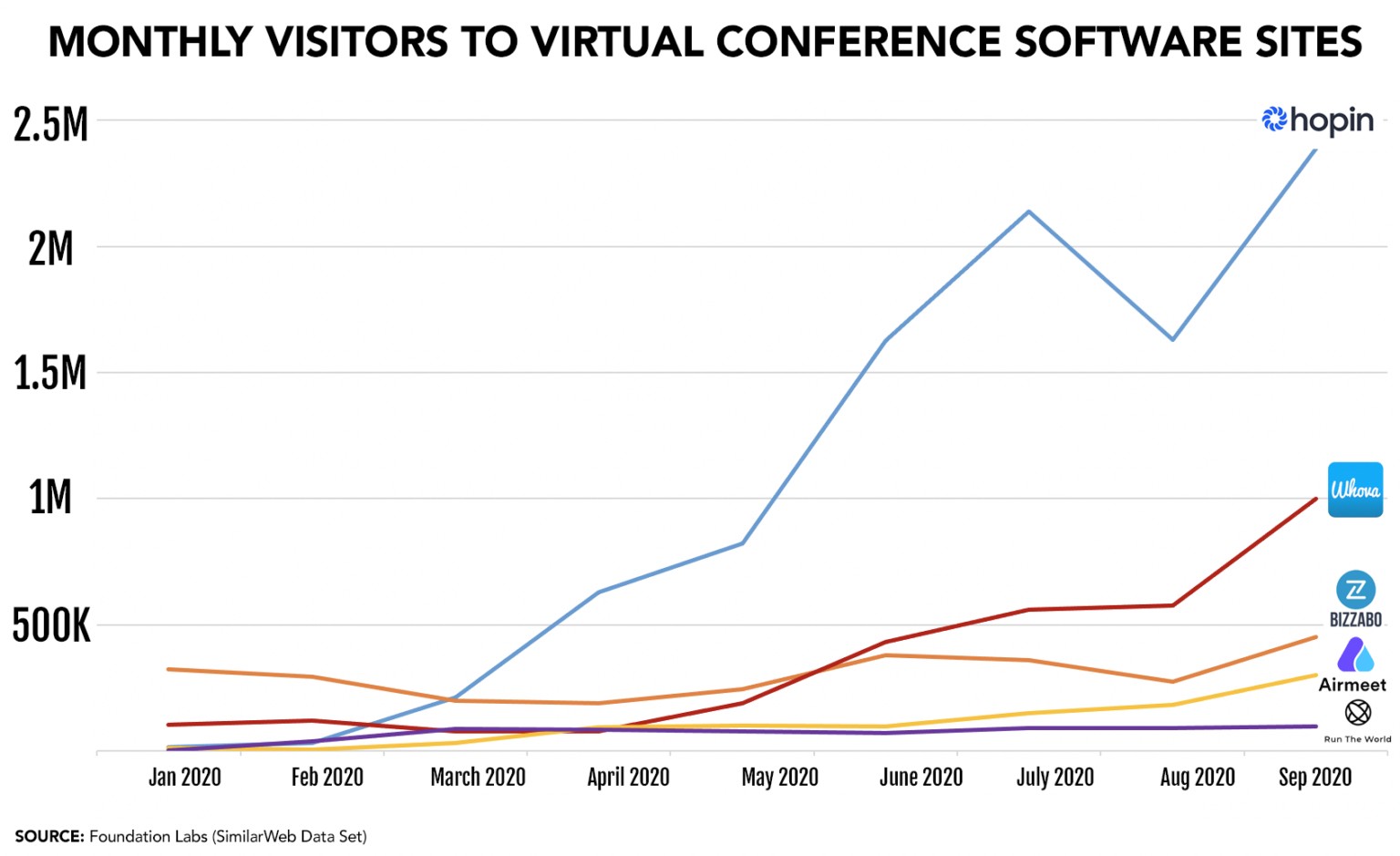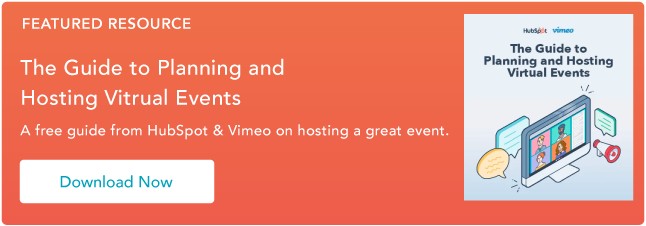After being diagnosed with an autoimmune disease, Johnny Boufarhat was no longer able to leave the house—let alone go to in-person events—and was looking for a better way to connect with others. In 2019, Boufarhat founded Hopin to bring meaningful connections to virtual and hybrid experiences.
Hopin—one of the fastest-growing companies—is a virtual experiences platform redefining how people around the world connect through immersive video experiences. Hopin’s founding product was a virtual event platform that mirrors the interactive nature of in-person events, conferences, and meetups.
By early 2020, Hopin had over 20,000 event organizers on the waiting list. Today, Hopin employs a fully remote workforce of over 550 people in 42 countries, has over 95,000 event organizers using its platform, and has secured $565 million in Series A-C funding. The company has also impressively reached $80M ARR.
Its exponential growth is fueled by its remote-first workforce and customer-centered acquisition strategy. Hopin has extended its vision to create more engaging video experiences into three new verticals through multiple strategic acquisitions with a product portfolio that spans events, live streaming, content hosting, and team-based collaboration.
An Industry Propelled by the Pandemic
In 2019, the virtual events market was valued at $77.98 billion. But in-person events were still the norm. From scientific conferences to sales summits, job fairs, and networking events to concerts, virtual events weren’t yet commonplace.
But by March of 2020, as lockdowns and travel regulations began, organizations were at risk of event cancellations. Event organizers had two choices: they could either cancel events entirely or adapt and pivot online. In response, the virtual events industry skyrocketed overnight.
As a company focused on recreating the in-person experience online, Hopin was well-positioned for the task at hand. Hopin is an event management software company allowing individuals and organizations to build and host virtual and hybrid conferences, trade shows, career fairs, and more. The company is committed to driving authentic human connections and replicating the in-person experience online with video and integrated tech tools like virtual whiteboards and live polls.

Hopin uses subscriptions for event organizers to access the event software. Meeting multiple price points and customer needs, Hopin offers different subscription tiers, with the starter option beginning at $99/month. Business and enterprise options give customized packages and subscriptions for larger organizations.
Subscriptions create a sustainable revenue model for Hopin, bringing some income predictability to the company. Hopin brings in additional income through ticketed events on Hopin Explore—a platform similar to Eventbrite helping users discover events—with a 7% commission fee on ticket purchases.
Forward-thinking and perceptive, founder Johnny Boufarhat continues to uncover customer needs and prepare Hopin for the new generation of events. What started as a response to his diagnosis evolved into a hybrid platform that completely revolutionized the virtual event space.
Even as vaccines roll out and travel restrictions adjust, the virtual events market is expected to keep growing at a rate of 23.2% and reach $404 billion in the next six years. Hopin is here to stay.
Launching 6 Months Early with a Fully Remote Workforce
In early 2020, Hopin had 12 employees. The original plan was to launch in the fall of 2020, allowing Johnny time to focus on raising funds and developing the company’s suite of services. However, spurred on by in-person event cancellations in March, Johnny and his then small team decided at midnight on a Friday to launch for a conference at risk of cancellation the following Monday.
Hopin could have waited to launch until everything was “ready,” but if ever there was a moment to launch a platform that mirrored in-person interactions and connections, now was the time. Johnny and team stepped in when thousands of event organizers so desperately needed the help.
At this point, no completely remote company had grown so quickly and exponentially. There was no roadmap to follow. No go-to-market strategy. The company had launched in such a short amount of time with a fully remote, growing workforce. It was full speed ahead and growing at an astonishing pace.
Johnny Boufarhat, CEO and Founder of Hopin said:
"Speed has become one of Hopin's superpowers both in scaling our multi-product platform and incredible, fully-remote workforce. At Hopin we prioritize impact measured by the success of our customers. Our mission is to provide the best possible platform for organizers to create meaningful experiences so the world feels smaller and more connected."
Early on, the majority of Hopin employees came through referrals from other employees. Johnny attributes Hopin’s success to his hiring strategy and leadership philosophy: providing flexibility and autonomy for a fully remote workforce.
Johnny is more concerned about hiring the right people over hiring people from a certain timezone. Having remote talent allows you to bring in the BEST of the best—and find the right culture fit—instead of needing headquarters in a certain country or city to get the right talent. Remote gives you a massive talent pool to build an effective team.
So how does Hopin continue to attract a global pool of top product and engineering employees? With its company culture. Between its very own Vibe Team, active Slack channels, and twice-a-month game nights called ConnectFest, Hopin fosters connectedness for its employees, too.

For Hopin, business norms aren’t necessary. Working across time zones means employees have flexible schedules. The where, how, and when of working doesn’t matter to Johnny; there’s no digital shoulder-tapping or micromanaging. Hopin’s leadership is mostly concerned about serving the customer, not wondering whether employees sit in their desk chairs between designated hours.
Instead of fearing a loss of control over the business, Johnny places trust in his team. Giving them autonomy and empowering them to take responsibility/ownership. Hopin’s success demonstrates the power of trusting in your remote workforce. With a commitment to remote-first forever and employee autonomy, Hopin draws top talent from across the globe.
Invest in Ecosystem Partners
Using integrated technology, Hopin aims to foster lasting connections among its users. Over the course of one year, Hopin has rapidly built an infrastructure to prepare for the future including an aggressive acquisition strategy to become a multi-product platform leading the way in hybrid events.
As part of its multi-product strategy, Hopin acquired mobile app development company Topi in 2020 as well as video streaming company StreamYard, adding StreamYard’s 3.6 million video content creators to its base.
In early 2021, Hopin acquired video hosting provider Streamable as well as video technology company Jamm. Furthering its mission to become the leading hybrid event platform, Hopin acquired event management company Boomset this June.
Johnny’s merger and acquisition strategy is helping Hopin create a digital ecosystem; a collection of interconnected technology to serve its customers. Rather than operating in silos—or having customers lean on multiple platforms that don’t necessarily communicate well with each other—Hopin makes every component of event planning, execution, and attending, easier.
Having an ecosystem is critical for software growth, as the integrated technologies function together to create a seamless experience for customers.
Hopin’s M&A strategy is twofold: increasing its capacity and improving its brand awareness. Through acquisitions, Hopin’s grows its capacity to serve customers with new tools while introducing a new audience to Hopin’s platform.
Like Hopin, companies need to weigh the financial and opportunity costs of acquisitions. What’s the cost of developing technology on your own? What’s the cost of waiting to bring your customers what they need right now? How much of an audience will the new company bring in?
Johnny knows the value of deciding and acting quickly—the faster he provides a better solution for his customers, the bigger the moat he creates around Hopin.
Hopin’s acquisition approach is to serve the virtual and hybrid event market from every angle and entry point, leveraging technology to help users connect with each other, experience global events together, and build lasting relationships across the world.
Growth During a Time of Economic Uncertainty
Johnny recognized the need for virtual and hybrid events well before the pandemic. As a trailblazing business owner, he didn’t let the murky waters of last year stop him from growing Hopin’s impact.
The company quickly positioned itself as THE virtual and hybrid events platform. Johnny leads Hopin to continuously improve its product suite and provide a memorable experience to expand Hopin’s brand awareness. With the backing of his investments in talent and acquisitions, Johnny carved a new moat in the events marketplace.
Hopin continues to establish its moat by refining and expanding its products. What sets Hopin apart is its emphasis on mirroring the dynamic, interactive nature of in-person events and bringing those experiences online as well as investing in technology to lead in the future of hybrid events.
With 1:1 networking, digital reception lobbies, expos, and even coordinating virtual swag bags, Hopin considers every piece of the event production process to provide memorable and interactive experiences for organizers and attendees alike.
Last spring, when The Atlantic searched for a platform for its festival, the company knew it needed something that wouldn’t cripple under the weight of thousands of attendees. Hopin’s platform can handle 100,000+, making the product an easy choice for event organizers with a significant number of attendees.
Its tech capabilities have made all the difference: leading to quick customer acquisition and expansion. The Wall Street Journal hosted its first virtual event on Hopin last year. So did the United Nations. Hopin has taken SEO rankings by storm with extensive backlinks from reputable sites, every event driving visitors and leads to Hopin’s website:

When big-name organizations flocked to one platform, the market paid attention. Small and large organizations across sectors now depend on Hopin to host virtual and hybrid events, including Poshmark, TechCrunch, WeTransfer, and many others. In March 2021 alone, the company saw active event organizers grow from 85K to 90K.
One thing is certain: new moats aren’t impenetrable. Once business owners create a new position in the market, the work isn’t done. Companies need to anticipate the changing tides, rather than waiting for inevitable shifts. Where are there gaps in your product or service offerings? How can your company go above and beyond for its customers?
Even now, Hopin is preparing for the world to go back to normal by expanding its products and services to execute hybrid events—blending in-person and virtual elements to serve a wider audience.
Johnny shows us the importance of understanding every facet of your market; he aims to meet needs and exceed expectations for event organizers AND event attendees alike. Hopin notices what’s missing in the market and brings every piece of the event puzzle together as the one-stop shop for a full-service video event platform.
Leading the Next Generation of Events
At first, catapulted by the pandemic, virtual events were used out of necessity. But now, event organizers see the opportunity in hybrid events: serving a wider audience and making a bigger impact. Founder Johnny Boufarhat aims to make events more accessible and create an environment for connections as natural as an in-person. He’s bringing in the next generation of events through three key strategies:
1. Committing to remote-first.
Hopin isn’t concerned about when, where, or how team members complete their work. The company fully leans into remote-first, allowing flexibility and autonomy for every employee. Above all else, Boufarhat trusts his team to take ownership and do what it takes to get the job done.
2. Investing in strategic M&A.
When it comes to mergers and acquisitions for Hopin, there’s no ego involved. More than anything, Hopin is focused on solving customers’ problems and frustrations—finding innovative solutions to help customers create meaningful experiences and make the world feel smaller.
3. Carving and expanding a new moat.
Hopin didn’t stop at creating a new position in the market. The company is committed to continuously discovering new ways to fill gaps in service and expanding its product offerings to meet customer needs in one place.
Through strategic acquisitions and investments, Johnny Boufarhat demonstrates his careful consideration of customer frustrations, combined with his ability to anticipate future possibilities and act quickly. Rather than waiting for customers’ needs to show themselves, Boufarhat goes beyond what’s in front of him and anticipates the bend in the road ahead: hybrid events that promote scalability and greater access.

